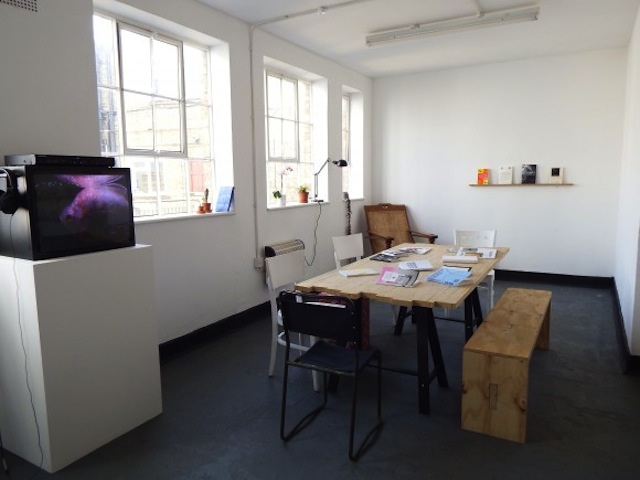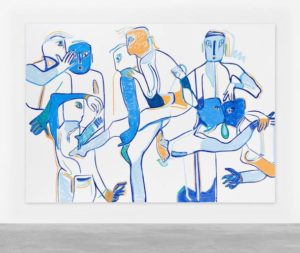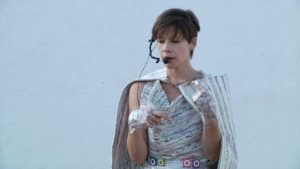The title of the David Roberts Art Foundation’s two-day programme Present Fictions is explicitly referring to fictions of the ‘now’ – what the introduction describes as “contemporary approaches to visual culture, poetry, science fiction and narrative structures”. By the time the series is complete, it feels like it could just as well be its homograph: a variety of fictions having been presented, stepped inside of, tested out, and contemplated.
In fact, the “present” preface is in some ways misleading: the fictions of now tend to look forward, applying imagination to our current technologies and ways of life to fictionalise tomorrow. This is what Cher Potter, senior research fellow in Design Futures at the V&A, addresses in her introductory talk on ‘The Speculative Arts’. With a focus on design fictions, she runs through introductions to a reel of artists and designers who are currently in the process of constructing our futures, both in the realm of ideas and in the “real world” – there are tales of sheikhs turning up at exhibitions only to write $3 million cheques bringing imagined drone systems to life, and of NASA funding scent provocateur Sissel Tolaas to research the making of cheese from human by-products. Because who knows when that might save the life of a future astronaut stranded in the cosmos?
As a counterpoint to this overview of future-facing art – running the gamut from trend-forecasting to Gulf Futurism – is University of Westminster researcher Robert Cowley’s exploration of the concept (and actuality) of the “Eco-city”. These sustainable, in many ways utopian, living spaces exist on a knife-edge between speculation and reality, raising as many questions as they set out to answer. What is the ideal city, and how does one set out to plan one? The Eco-city and science fiction exist in a chicken-and-egg style feedback loop, one inconceivable without the other; rather than fiction that informs how our futures might look, these are examples of present, actual indications of the future as informed by sci-fi. Masdar, a city in UAE powered entirely by renewable energy, is being built right now while the hyperbolically marketed Sejong City is bringing South Korea’s dreams to life.
My Bodies from Hannah Black on Vimeo.
While this is a pretty literal example of world-building, Potter deals more with artists who are “world-hinting” through the micro-futures they create in their objects, and this kind of hinting is something observed throughout the two days at Present Fictions. The video art of Hannah Black and Hannah Perry deals in the meshing of fragmented pop culture, narrative and personal insight to create impressions of a writhing digital world engaged in a love-hate relationship with the human mind and body: in Perry’s ‘While It Lasts’ (2012)’, the infinite moment of pleasure promised to young people by the media is detailed in a way that almost mimics the techniques of the ads and music videos it takes from, ending on the tantalising promise of Nina Simone’s distorted voice trailing “And I’m feeling…”.
Meanwhile Black, who incidentally tweeted over the weekend “i do not love anything or anyone more than i love pop music”, picks apart the disjunction between actual bodies and our digital and cultural understanding of them, through the disembodied limbs that “learn to dance like Rihanna” while images of her bruised 2007 face loom in the background, to the disconnect between woman R&B vocalists singing about their “bodies” over stock photographs of powerful white men in suits. Perry shows the tragic fiction of the ultimate, perfect presence, perpetually pushed just slightly in the future and made just slightly unobtainable, while Black swims through the nexus of imagery through which we encounter pop culture, and how that makes us feel about ourselves. Pop is ultimately, genuinely loveable because it’s our most dominant present fiction: nothing else creates a shared imaginary moment for so many people in one stroke, creating an immense community and false sense of security in its view of the world.
In the second day’s poetry readings, Tender journal editor Rachael Allen (@r_vallen) also turned a hand to world-hinting through the objects and characters that loomed through her newest poetry, in which she said she was exploring a world of “surreal” homes, filled with quarrelling sisters (making their house into a “cathedral of pinches”) and babies bubbling on stoves. This world, born out of childhood memories meshed with childhood fantasies and brewed over years of re-contextualising, was a present fiction of an imagined past. Faber poet Sam Riviere gave sharply defined glimpses into the world as it is through the found poetry of his Kim Kardashian’s Marriage series. Assembled from a collage of texts found online, the poems speak straight from a digital mouth, all shiny falsity and dry, dulcet tones masking something more desperate.
On the back of this reading comes Rozsa Farkas’ performance lecture ‘It’s Not Me, It’s You’ – the first part of which can be listened to above or read in its entirety on the latter link – and which inspired her work in THE ANGRY SHOW, during which she advocates pure anger over the detached removal of cynicism, ironical reactions to systems being complicit to the systems they decry through their inaction. With a backdrop of videos from Ciara, Bikini Kill, Nirvana and an impassioned, arm-thrashing mime to Taylor Swift’s ‘I Knew You Were Trouble’, Farkas tells a story of a world in which “angering” is forbidden, and a young girl who discovers what a force the emotion can be through a cultural Mesh and a whistle-stop tour through the history of counter-culture. This is a world built in front of our eyes that’s not so removed from our own, a fiction that tells us something about the present via a theoretical future; like so much of this weekend, its presentation of a fiction that borders almost uncomfortably on reality is so absorbing that it brings with it the realisation of how such fictions pervade every moment in our engagement with culture, in our narrative sense-making of our own lives. The present is a fiction, fiction a presentation of our world. **


















